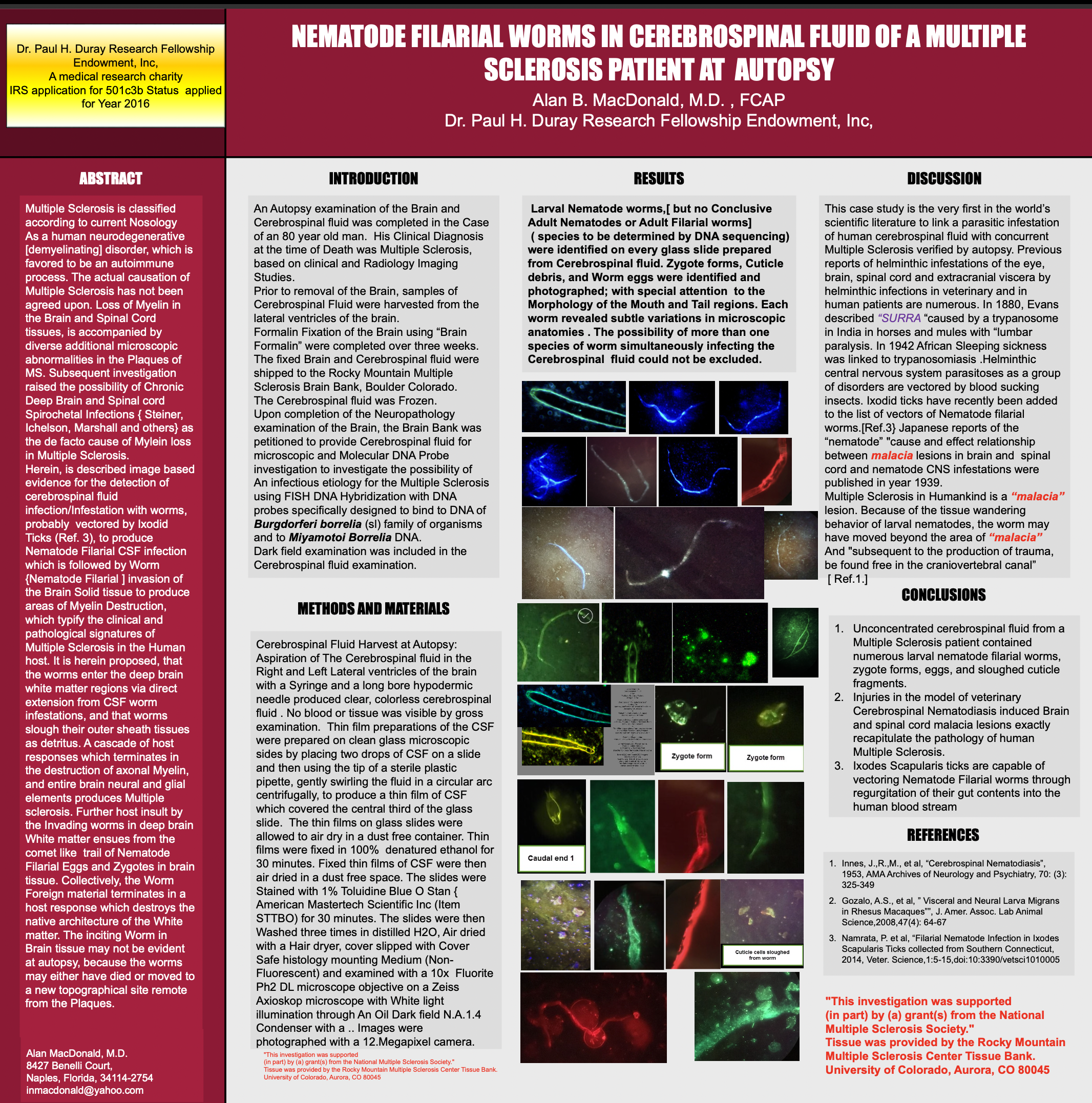US pathologist Dr. Alan MacDonald discovered many roundworms in the spinal fluid of every MS subject that he studied. This is very significant because for over 100 years, veterinarians have known that when these small worms are present in the spinal fluid of domestic animals, they have symptoms identical to MS. Pam Bartha discusses this ground-breaking research and how it confirms that MS is an infectious disease caused by a parasitic infection.
This topic is very important for 4 specific reasons:
- Pathologist Dr. Alan MacDonald found MANY filarial worms in the spinal fluid of EVERY MS subject he tested – in 10 out of 10 patients.
- One of our previous students in the Live Disease Free Academy who was a medical student and suffered from MS, tested her blood and the blood of another MS patient. She stated that it was quite easy to identify these worms in their blood using a simple finger prick. She has shared the worms pictures with me and is publishing her findings.
- Many studies show that when these filarial worms are present in the central nervous system of domestic animals, they have symptoms identical to the symptoms of MS such as extreme fatigue, tingling, numbness, balance issues, spasticity, drop foot, weakness, paralysis and much more.
- Our students in the Live Disease Free academy most often test well for and experience great symptom improvements when they are prescribed antiparasitic medications that treat roundworms.
Filarial worms
There are at least 8 different filarial nematodes that cause disease in humans. Other types of filarial worms that infect animals can also be passed onto humans.
Filarial worms are slender and thread like in shape and are usually 2 to 10 cm long. Females give birth to larva known as microfilaria.
They are transmitted to humans through biting insects like mosquitoes, black flies and ticks.
Different types or species of worms infect different parts of the body. For example, they can infect the eyes (river blindness), lymphatics (elephantiasis), skin (rashes and pigmentation), intestines, blood vessels and central nervous system.
Depending on the type of worm and where it lives in the body, it can cause rashes, arthritis, hyper or hypo pigmentation of skin, abdominal pain, fatigue, and in animals they can cause neurological symptoms associated with multiple sclerosis such as extreme fatigue, tingling, numbness, balance issues, spasticity, drop foot, weakness, paralysis and other neurological symptoms.
Setaria digitata is a filarial parasite that causes fatal cerebrospinal nematodiasis in goats, sheep and horses.
When filarial worms are present in domestic animals like dogs, cats, horses, sheep, goat, cattle and horses, they cause symptoms of extreme fatigue, tingling, numbness, balance issues, spasticity, weakness, paralysis and death. Veterinarians have known this for over 100 years.
Dr. Alan Macdonald discovered small nematode worms in the spinal fluid of every MS subject he tested. He stated, “We have not found a case of MS that does not have worms in the CSF (cerebrospinal fluid).”
From his discovery, he believes that multiple sclerosis is a neural larval migrans illness caused by a parasitic infestation of the CNS (central nervous system).
Nematodes were not identified in the spinal fluid of animals or humans until 2016 by Dr. Alan McDonald. Previously, researchers only looked for nematodes in the brain, but it is hard to find them in the brain because once they cause the damage to the brain, they move on. Where it took hundreds of slides to find one worm in the brain, Dr. MacDonald stated that it very easy to find them in the spinal fluid.
He explained that the worm migrates and creates a storm of injury in its wake – like the tale of a comet.
Unfortunately, microscopic examination, or making smears as Dr. Alan McDonald did, is not routinely done in any laboratory or in any hospital or medical school around the world today. His team was the first to examine spinal fluid for these worms.
He suspects that more than one species of nematode is present in the spinal fluid of MS patients.
The filarial worms and their larvae in the spinal fluid destroy myelin and nerve tissue and that’s exactly what happens in multiple sclerosis. Multiple sclerosis has a migratory pattern in the brain. It flares up in one area and then calms down and then flares up in another area and then calms down.
In 1880, researchers discovered worm parasites in the brains of domestic farm animals. The worms caused brain injuries. Myelin and nerve tissue were destroyed and this is exactly what happens in multiple sclerosis.
Then from 1880 to 1950 researchers continued to study these worms in the brains of animals. They suggested that these worm infections could cause similar diseases in humans, but no one studied this until Dr. Alan MacDonald.
Treatment for filariasis
The following information is for educational purposes only and it is not intended to substitute for the necessary care of your healthcare professional. It’s very important to work with a healthcare professional when you are treating parasites.
Some medications will treat microfilariae but not the adult filarial worms.
Parasite Drugs:
Ivermectin, Albendazole, DEC (dimethyl carbamazine), levamisole, fenbendazole, moxidectin, and others.
The use of a single parasite drug has not been shown to be effective in fully clearing filarial worms. A triple therapy of albendazole, ivermectin and DEC appears to be more promising.
Our students have more success eradicating parasites by implementing the Live Disease Free plan where they take steps to support the body and then treat the parasites using a layering of therapies.
Dr Alan MacDonald’s lecture about filarial worms in MS spinal fluid
Dr Alan MacDonald’s research poster about Filarial worms in MS spinal fluid
Other videos about filarial worms:
Filarial Worms and Neurological Diseases
Available Tests for Filarial Worms Found in Multiple Sclerosis Patients
The most effective treatments for filarial worms
Dr. Alan’s research provides huge insights into the true cause of multiple sclerosis and other chronic diseases, especially neurological diseases. He is the first to identify living parasites in the central nervous system of MS patients at the time of their death. His work is more proof that MS is an infectious disease caused by a parasitic infestation.
There are real solutions to recover from parasites today!
To restore health, we must focus on treating the cause of inflammation, which are parasites. First, identify the enemy (parasites), then support the body and treat the parasites while following a holistic approach. When parasitic infections are treated effectively, we can overcome inflammation or disease.
If you’re frustrated with the fact that our standard of care STILL doesn’t offer a real solution for treating MS and other diseases, then click on the link below to watch Pam Bartha’s free masterclass training and discover REAL solutions that have allowed Pam and many others to live free from MS and other diseases.
CLICK Here to watch Pam’s masterclass training
Or take the Health Blocker Quiz to see if you could have parasite infections
Resources
https://www.sciencedirect.com/topics/agricultural-and-biological-sciences/setaria
https://www.ncbi.nlm.nih.gov/pmc/articles/PMC6760958/
https://www.cochranelibrary.com/cdsr/doi/10.1002/14651858.cd003753.pub4/full
https://pubmed.ncbi.nlm.nih.gov/35080325/

Clinically diagnosed with multiple sclerosis at the age of 28, Pam chose an alternative approach to recovery. Now decades later and still symptom free, she coaches others on how to treat the root cause of chronic disease, using a holistic approach. She can teach you how, too.
Pam is the author of Become a Wellness Champion and founder of Live Disease Free. She is a wellness expert, coach and speaker.
The Live Disease Free Academy has helped hundreds of Wellness Champions in over 15 countries take charge of their health and experience profound improvements in their life.


